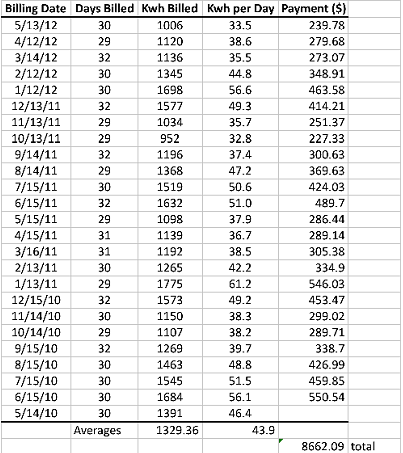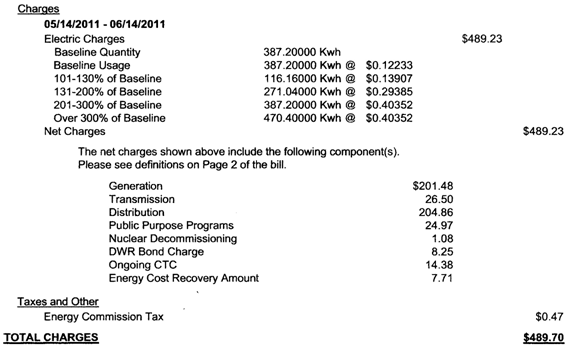Reference no: EM135273
1. Sizing a Solar PV System
The Rusk's own fairly large house near San Francisco and the subsequent spreadsheet shows their month-to-month energy use for two years.

1a. What is their monthly average energy use? Why do you suppose their use peaks twice a year?
1b. Evaluate the size of the solar PV system (kWh DC,STC) they will need in order to have a zero dollar electricity bill yearly (use an average over the two years). Suppose that you are using 14.9% efficient panels with an 80% de-rating factor. Also consider that your inverter is 95% efficient. Use an average solar insolation of 5.5kWh/m2/day for their location.
1c. Suppose this system will be mounted on the roof. How big will the area of solar collector be? Is this a reasonable size for a house (i.e. are roofs really this big)?
1d. What do you meant by the AC,PTC per square meter for the system? Consider that the 80% de-rating factor gets you from DC,STC to DC,PTC.
2. A solar thermal salesman heard about the Rusk's solar PV system and selected to convince them to use part of their roof for solar thermal instead of solar PV.
2a. If the thermal solar collectors are 70 percent efficient and the aperture area is 70 percent of the area covered by the solar thermal collector system, how many kWhs of energy per square meter is recovered considering 5.5 kWh/m2/day? How many BTU's?
2b. The tap water comes into the house at 60 oF and is heated by the thermal solar system. How many gallons of this water will be heated to 130 oF per day per square meter of solar thermal system?
3. The solar PV company comes back with a quote for the financing of the solar PV system and purchase. The total system with installation will cost $54,000.
3a. The federal government provides them a 30% tax rebate. Considering an interest rate of 7.5% for 15 years, what may be their monthly payment for the installed system?
3b. Using the data in problem 1 (i.e. use the average cost per year averaged over both years), evaluate the payback period for their system?
4. Looking at the other part of the Rusk's PG&Ebill. You will see that they are spending a lot of money in levels 3, 4, and 5 (>131% of baseline). You will also see that the cost per kWh in levels 3, 4, and 5 is more than double that in levels 1 (baseline) and 2.

4a. Use the data above to evaluate the size of a solar PV system (in kWh DC,STC) they need if they only wanted to always remove their expenses in levels 3, 4, and 5? Size the system based on this bill alone rather than an annual average.
4b. What is the payback period for this system? Suppose that the price scales linearly with DC,STC size using the installed price in problem 3.
5. A 20-kW CHP system has a thermal efficiency of40% and an electrical efficiency of 40%. Its $45,000 cost is paid for with an 7.5%, 20-year loan having annual payments of $4386/year. Its heat output displaces gas costing $10 per million Btu that would have been burned in an existing 85%-efficient boiler. If the CHP system has a capacity factor (CF) of 0.90 (in essence it runs only 90 percent of the time during which it delivers the full20 kW), evaluates its cost of electricity.
6a.What would the cost of cooling be envelope portion only for a UA = 450 Btu/hr-°F house in Houston with 72% efficient ducts, an AC with SEER = 10, and electricity that costs $0.15/kWh? From Table 7.4, Houston has HDD65 = 1434 °F-day/yr and annual average temperature of 69°F.
6b. Assume a 2150 ft2 house with 8-foot ceilings has an infiltration rate of 0.45 ach. Find the cooling load related with dehumidifying infiltration air from ambient 85°F, 80% rH toa nice AC supply at 65°F, 40% rH. Suppose air density is 0.075 lb/ft3. If we imagine an SEER = 10, 70% ducts, $0.10/kWh, AC handling the dehumidification of infiltration for 100 days of summer.